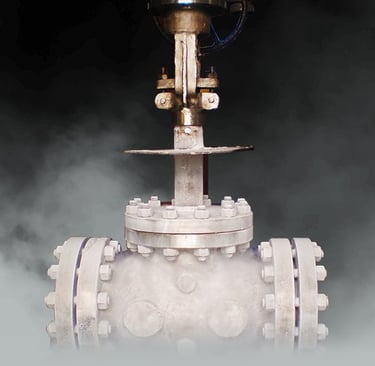Cryogenic Valves


1. Size Range:
Typically available in sizes ranging from 1/4" to 24" (DN 6 to DN 600) or larger depending on the application.
2. Pressure Ratings:
Cryogenic valves are available in pressure classes from 150# to 1500# (PN 10 to PN 100).
Pressure ranges typically cover up to 50 bar (725 psi) but can vary based on the valve type and material.
3. Temperature Range:
Cryogenic valves are capable of functioning at extremely low temperatures, typically from -196°C (-320°F) up to ambient temperatures. They are designed to perform in temperatures as low as -269°C (for applications like liquid helium).
4. Material Specifications:
Body Materials:
Stainless Steel: 304, 316, 316L (common due to excellent low-temperature properties)
Carbon Steel: Often with austenitic stainless steel internals for strength and cryogenic stability
Bronze and Brass: For lower-pressure and non-corrosive applications
Monel, Inconel, Hastelloy: For highly corrosive cryogenic media
Seating Materials:
PTFE (Teflon), PCTFE (Kel-F), or other soft seat materials suitable for cryogenic conditions to ensure bubble-tight sealing.
5. Valve Types:
Globe Valves: For precise control of flow in cryogenic systems.
Ball Valves: Often used for quick on/off control in cryogenic systems.
Gate Valves: Typically used for isolation in larger cryogenic systems.
Check Valves: Ensures unidirectional flow in cryogenic pipelines.
Butterfly Valves: Used in larger cryogenic applications for flow control.
Needle Valves: For fine-tuned control in cryogenic instrumentation systems.
6. Design Features:
Extended Bonnet: Most cryogenic valves feature an extended bonnet to ensure that the stem packing stays well above the cold zone, preventing freezing and ensuring the integrity of the seal.
Low Emission Sealing: Ensures that emissions are minimized, meeting strict environmental regulations like ISO 15848.
Double Sealing System: A secondary seal is often incorporated to ensure safety in case of failure of the primary sealing system.
Fire-Safe Design: Fire-safe cryogenic valves are designed to contain pressure and prevent leakage during fire exposure.
Anti-static Device: For ball valves, especially those used in cryogenic services, to prevent static electricity buildup.
7. End Connections:
Butt Weld Ends: Common in high-pressure cryogenic systems to avoid leakage.
Socket Weld Ends
Flanged Ends: ASME, ANSI, DIN, and JIS standards are followed.
Threaded Connections: NPT, BSP, etc. (usually for smaller valves).
8. Applications:
Liquefied Natural Gas (LNG): Valves used in LNG storage tanks, pipelines, and marine applications.
Air Separation Plants: For gases like oxygen, nitrogen, and argon.
Cryogenic Tankers: Used in transportation of liquefied gases at very low temperatures.
Medical Gas Supply: For oxygen and other medical gases used in healthcare systems.
Space and Aerospace Applications: Handling liquid oxygen and hydrogen in space exploration.
9. Standards & Certifications:
Standards:
BS 6364: Cryogenic Valve Standard
ASME B16.34: Valves for pressure-temperature ratings
ISO 21011: Cryogenic vessels and equipment standard
API 6D: Pipeline valve standards
Certifications:
Fire-Safe certification as per API 607 or ISO 10497.
Fugitive Emission testing to ISO 15848.
Low-Temperature Pressure Testing: Ensures the valve’s integrity at cryogenic temperatures.
10. Testing:
Cryogenic Testing: Performed at specified cryogenic temperatures to ensure the valve operates effectively under extreme cold.
Pressure Testing: Hydrostatic and pneumatic tests under ambient and cryogenic temperatures.
Leak Testing: Usually helium leak testing is performed to detect any possible leakage from the valve body or seat.
Seat Leak Test: Conducted as per API 598 to ensure bubble-tight sealing under cryogenic conditions.
QUALITY
Supplying High-Quality Plates, Wire Mesh, perforated Sheets, Coils, All types of Flanges, Round Bars, Fasteners, Vales, Strainers etc.
Contact us
Request a quote
✉️ Email:
admin@mw-enterprises.com
abdulwahab.ansari@mw-enterprises.com
📞 Phone: +91 90281 70158
MW Enterprises © 2024. All rights reserved. Developed by Seofy.in
Our sales & supply are in below countries:
Saudi Arabia, Qatar, Oman, Kuwait, United Arab Emirates (UAE), Dubai, Bahrain, Italy, Indonesia, Malaysia, Jordan, Sri Lanka, Vietnam, South Africa
Abdul Wahab Ansari
MW Enterprises General Trading Company
